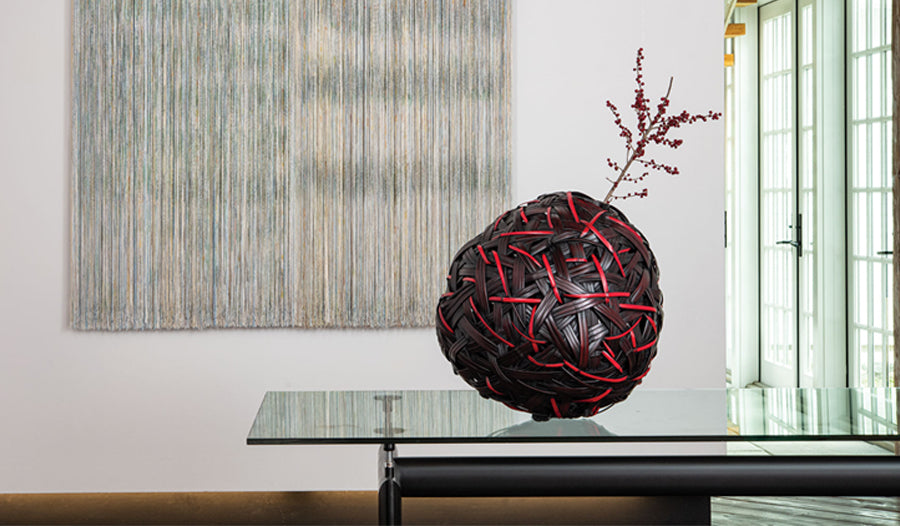
Japandi
 Image: Ulla-Maija Vikman, Akureyri, 2009, painted viscose, and linen, mahogany, 57” x 58”. Jiro Yonezawa, Red Fuji, 2019 bamboo, urushi lacquer, 30” x 12” x 10.5”. Photo by Tom Grotta
Image: Ulla-Maija Vikman, Akureyri, 2009, painted viscose, and linen, mahogany, 57” x 58”. Jiro Yonezawa, Red Fuji, 2019 bamboo, urushi lacquer, 30” x 12” x 10.5”. Photo by Tom Grotta
For over 30 years, browngrotta arts has been advancing the field of contemporary fibre arts by curating and exhibiting renowned artists who celebrate the exploration of fibre art techniques and drive the unique possibilities of materials. Representing many of the artists who have helped define modern fibre art since the 1950s, browngrotta arts is the passion project of husband and wife team, Tom Grotta and Rhonda Brown.
From 25 September - 3 October 2021, browngrotta arts’ forthcoming exhibition, Japandi: shared aesthetics and influences, will explore common approaches shared between Japanese and Scandinavian cultures through art. The show will feature 39 contemporary fibre and ceramic artists from Denmark, Finland, Japan, Norway, and Sweden.
Japandi is a hybrid union of Japanese and Scandinavian aesthetic approaches appreciated for its exceptional craftsmanship, simplicity and minimalism, reverence for nature and natural, sustainable materials, and the beauty of embracing imperfection. This union evokes a visual and physical sense of calm and tranquility.

Image: Eva Vargö, 7ev Japandí, Japanese and Korean book papers, 23.5” x 22.375” x 2.5”, 2021. Photo by Tom Grotta
The artistic kinship stretches back a century and a half ago when Japan’s closed border policy was lifted in 1858 and Danish designers and creatives began traveling to Japan. Early influence can be seen in ceramic crafts, architecture, and Danish furniture. After World War II, the Japanese government began promoting cultural exchange among designers and artists from Scandinavia.
The artists involved in the exhibition uniquely embody principal elements of what is currently termed Japandi style - from their use of natural materials and neutral color palettes to the fundamentally “slow art” process of hand craftsmanship. The core of their processes and materials are invoked with an intrinsic sense of contemplation, tranquility, and harmony that reverberates through their work and into the spaces the artworks inhabit. Materials come from regionally or locally sourced plants and works made of soft materials such as linen, cotton, or wool are handwoven in meticulous detail and add warmth and calm in modern interiors. Both cultures make room for reuse, artful imperfection, and comfortable simplicity, through the Japanese concept of wabi-sabi and the Scandinavian idea of hygge.

Image: work by Hiroyuki Shindo
Japandi: shared aesthetics and influences will feature more than three dozen artists from six countries whose works are complementary in approach and execution. Kay Sekimachi’s (Japan) folded tower sculptures are made of antique Japanese gampi paper treated with persimmon tannin. Hiroyuki Shindo (Japan) hand weaves fabrics developed through his own system for natural indigo dyeing, a process that takes several days to complete. For her large-scale textile work, Ane Henriksen (Denmark) replicates strips of webbed rubber matting based on the oil-tainted discarded materials she found washed up along the West coast of Denmark, challenging the viewer to address global environmental issues. Chiyoko Tanaka (Japan) sees weaving as a representation of time passing. Through her process of “grinding,” she elevates the less-than-perfect, distressing her linen weavings on the ground over brick or stone, embedding the earth onto her work.
Japandi: shared aesthetics and influences will be on display at browngrotta arts, Connecticut, from 25 September - 3 October.. Advanced time reservations are mandatory, and free tickets are available here: Japandi: shared aesthetics and influences Tickets, Multiple Dates | Eventbrite
